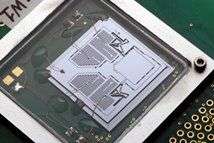New data storage method optimized

Increasingly more memory on increasingly smaller surfaces; the storage capacity on mobile equipment is improving every day. Johan Engelen from the MESA+ Institute for Nanotechnology of the University of Twente (The Netherlands) optimized a new storage technique by adding another motor. The storage method is now ten times more energy-efficient than the old technique. He will receive a PhD from the Faculty of Electrical Engineering, Mathematics and Computer Science on 14 January.
The memory capacity in telephones has grown considerably over the past few years; increasingly more memory on increasingly smaller surfaces. External hard disks and USB sticks are also getting smaller while offering more storage capacity. According to researcher Johan Engelen from the University of Twente, infinite storage capacity for applications is just around the corner. "The data storage capacities need to catch up, and we need to develop new techniques," explains Engelen. Engelen studied one of the new storage techniques, which he optimized by adding another motor, enabling it to use ten times less energy.
At the moment, flash memory is the golden standard for data storage. It is used in telephones and mobile devices, such as USB sticks. "Flash memory works with threads criss-crossing over each other to form a mesh, with a bit at every crossroads. The more bits, the larger the memory," explains Engelen. "During my research, I examined a new technique, which does not work with a mesh, but with a needle that reads the bits." The needle is driven by a motor. The principle of this new technique (parallel probe-based data storage) is the same as a record-player, whereby a needle moves across a disc and reads the structure.
Engelen decided to optimize the new storage method, as it used a relatively large amount of energy. There were, however, a few conditions that Engelen's technique had to satisfy. The technique had to increase energy-efficiency, without compromising on speed and shock absorbency. Using a different motor, a so-called comb drive, Engelen managed to make the motor work using ten times less energy. As a result, more energy remains during the movement to steer the needles. "The new technique is not yet ready to be marketed. Existing techniques are still so cheap and offer so much scope for expansion that we won't be ready for new techniques for another ten years," says Engelen.
Engelen also used the comb drive technique to design the smallest musical instrument in the world: the micronium. This musical instrument is made of springs just a tenth of the thickness of human hair, varying in length from half to a whole millimetre. A mass of a few dozen micrograms is hung from these springs. Earlier musical instruments of these minimal dimensions could only produce sounds that were inaudible to humans. But thanks to an ingenious construction technique, Engelen and a group of students succeeded in producing scales that were audible when amplified.
Provided by University of Twente





















